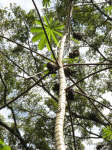
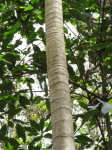
After a hot shower, a good nights sleep, and leisurely breakfast outside, Dona and I had a nice walk down to the entrance to the National Park containing the Mayan ruins of Copan. Along the way, we discovered that all the ruins aren't in the place designated. The Mayan city at Copan was huge, filling the entire valley, and there are ruins everywhere. It seems like everywhere you look, the hillsides are covered with ruins. On the trail along the highway from town to the park, we passed two large stelae, and noticed other fallen structures on the hillside.
Once we got to the park, we got sidetracked. There is a nature walk, and that seemed like something we needed to do. I guess we're both more interested in nature than ancient civilizations. Old civilizations are cool, but nature is really cool. We didn't see much in the way of wildlife, which was a disappointment. We saw an agouti, a lineated woodpecker, a few butterflies and lizards, and some crazy spider webs but no gigantic spiders. But we did see a lot of interesting trees and vines. Some of the trees were humongous, and the buttresses on others were even more humongous. One thing about tropical jungles, they have great possibilities for tree houses.
 |
 |
| Cool tree |
 |
 |
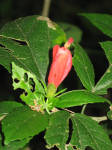 |
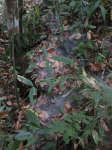 |
| Butterfly | Lizard | Flower | Cocoons |
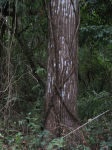 |
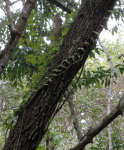 |
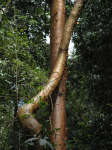 |
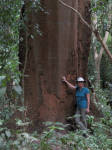 |
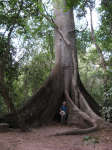 |
| Tree vines | Vines | Tourist tree | Big tree! | Tree with huge buttressed roots |
Along the nature walk, we came to one of several ball courts. The Mayans were playing ball over 3000 years ago -- well before western Europeans were doing much more than grunting. The Mayan games had many of the trappings of our modern games. The courts varied in size; some were larger than an American football field. There were walls along the sides, with stadium seating above and behind the walls. Later Mayan cultures had stone rings up high on the walls, and the object of the game was to get the ball through one of the rings. The ball couldn't touch a player's hands, so getting it through a ring was no easy task. Games were played by both sexes, and protective pads and helmets with animal decorations were used. Some games were simply played for fun, while others were serious affairs with ritual implications. For those games, the leader of the losing team was often put to death. Now that's motivation! I knew there was a reason I didn't like organized sports. I read that like many sports today, people gambled on the game. How the heck do the archieologists figure that out? A modern version, called ulama, is still played in a few places. Don't know if they sacrifice the losing captain or not...
The balls were hollow, made from rubber (latex), varied in size from grapefruit to watermelon, and weighed around eight pounds. Europeans made rubber balls hundreds of years later, but they weren't as fun -- they didn't bounce. The Spaniards were so puzzled by the bouncing Mayan balls they thought they (the balls, not the Spaniards) were under some kind of spell. The Mayans discovered vulcanization long before Charles Goodyear. They did it by mixing Morning Glories with rubber; Goodyear used sulfur.
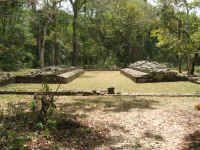 |
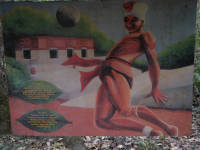 |
| Mayan ball field | Mural explaining Mayan ball game |
There is a more or less resident population of Macaws at the ruins. Their wings aren't clipped and they aren't caged, so they're free to come and go. But they are fed, so they stick around. In any case, they're cool birds.
 |
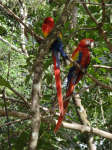 |
| Macaws |
The ruins themselves are impressive. I always have trouble wrapping my head around the reality that the "New World" was a rather old place when Europeans discovered it, and the inhabitants were doing pretty well when Europe was still in the dark ages. It's a tragedy and a disgrace that virtually all written knowledge was destroyed by the Spaniards when they went rampaging through. These ruins were well known to the local inhabitants in modern times, and nothing special. But imagine being the first person of your own culture to be wandering through the jungle and come upon them. The museum in the park has early photographs, and they make me want to have been there. What a great adventure!
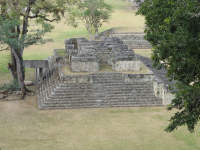 |
 |
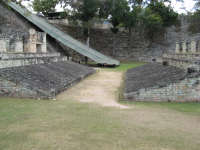 |
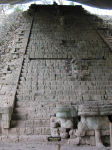 |
| Ruins | Ruins, covered stairs behind | Stairs |
Some of the Stelae are covered now, to prevent weathering of their features. The redish coloring on Stela C is original. The altars near some of the Stela were used for human sacrifices. There's a nice place to lay your head, and drain grooves for the blood.
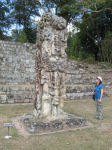 |
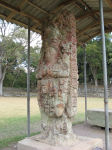 |
 |
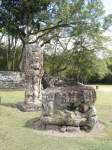 |
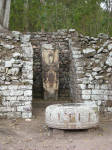 |
| Stela D | Stela C | Stela Altar | Stela Altar | Stela Altar |
Mayan pyramids were often built on top of older pyramids, forming a layer of structures. When this was done, the result was often a cave or tunnel like structure. One of the pyramids at Copan has been excavated inside and is open to the public.
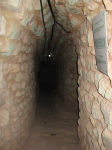 |
 |
 |
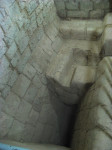 |
| Inside pyramid | Carving inside pyramid | Sanitary Drain |
Copan is one of the few sites that contains stone animals.
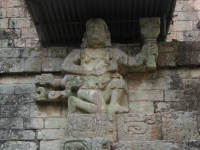 |
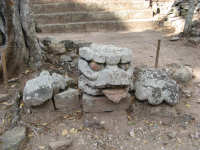 |
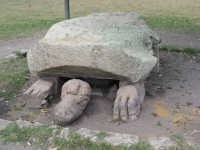 |
| Stone Carving | 'nother one | Turtle |
One of the things that blows me away when I'm traveling around Central America is the number of un-excavated Mayan sites. They are commonplace, and no big deal. Even in well-known, often-visited places like Copan and Tikal, you constantly run into them. You're just walking along and suddenly you become aware that the big mound in front of you with big trees growing out of it looks a bit funny.
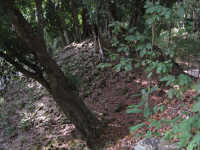 |
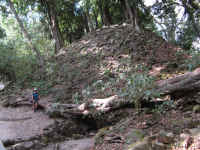 |
| Unexcavated ruin | Unexcavated ruin
|
The ruins are in a tropical jungle, so there are big jungle trees growing everywhere. I can't help it, I just think "tree-house". With flowers yet. We found one that was exceptional, perched on the unexcavated side of one of the pyramids.
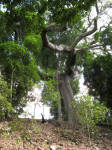 |
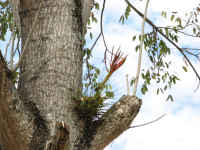 |
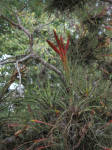 |
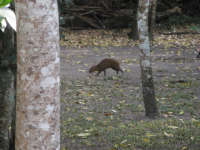 |
| Tree house tree | Epiphyte | Agouti |
After all those ruins we were ready for some more nature stuff, so we headed for a butterfly farm.